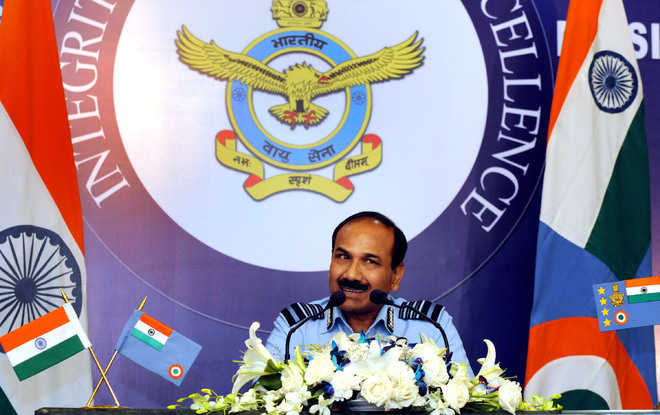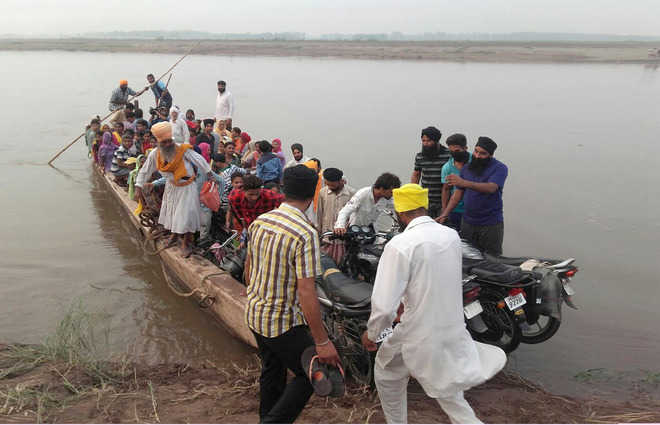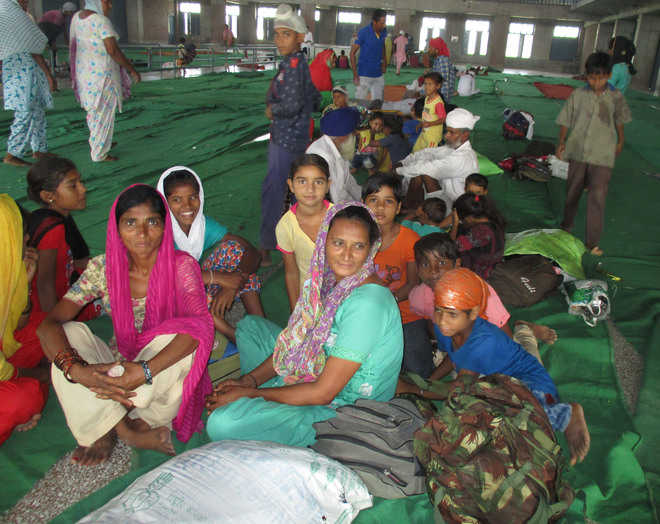Current Events :










JAMMU: There seems to be no end to ceasefire violations by Pakistan as it resorted to mortar shelling and unprovoked firing on Indian posts along the Line of Control (LoC) in Naushera sector of Rajouri district (5am) and Pallanwala area of Akhnoor sector in Jammu (1.35pm) on Tuesday. Later in the day, more ceasefire violations were reported from Naushera Sector of Rajouri and KG Sector of Poonch at 5pm.
AFPA Border Security Force (BSF) soldier patrolling along a fence at the India-Pakistan border in R S Pura, southwest of Jammu, on Tuesday.
“Unprovoked ceasefire violations by Pakistan started in Naushera and KG Sectors of Rajouri and Poonch districts respectively from 5pm. Firing stopped at KG Sector at 8 pm but continued in Naushera Sector of Rajouri district,” defence spokesman Lt Col Manish Mehta said.
Reports of ceasefire violation in Pallanwala sector came in around 1.35pm and continued till evening. Rifleman Dharender Bisht of 2/9 Gurkha Rifles was injured in the firing in Bhudwaal forward post of Khour area in Pallanwala sector in Akhnoor. He was evacuated by army authorities.
Col Mehta said Pakistan is using small arms, automatics and 82 and 120 mm mortars. “Our own troops are responding in equal measure,” he added.
A police officer from Pallanwala police station said Pakistan has been firing mortars on forward villages like Darkote, Platan, Channi Dewanu, Budhwal, Gagrial and Garar villages. Villagers had already moved to relief camps set up in government schools in safer areas, he added.
Meanwhile, an intelligence official said that Pakistan has been trying to push a group of ultras from Naushera sector since India’s surgical strike on September 29.
“This morning they tried once again to push the ultras. They are said to be five to six in number. The Indian army is alert to the situation,” he said.

Tribune News Service
New Delhi, October 4
IAF Chief Marshal Arup Raha today refrained to comment on the recent strikes at terror camps across the Line of Control (LoC), saying things were still “live” and the IAF had adequate capability to take on any contingency.“Things are still live, it would not be right for me to give a perspective now,” Air Chief Marshal Raha said at a press conference. He refused to take any question on the September 29 surgical strikes. “Our capability is not towards a particular country,” he said without naming Pakistan.Speaking about future plans, he expected the IAF’s fighter jet fleet to grow over the next few years and provide better capabilities. Over the next few years “we will manage the fleet with replacements and upgrade”.After the purchase of 36 Rafale jets from France, there is a plan to make fighter jets in India. The Light Combat Aircraft, Tejas, will be inducted in big numbers (106, including the upgraded version).Also there are plans to upgrade the Sukhoi-30 MKI — the IAF’s lead fighter jet that is based at Halwara and Bathinda in Punjab and Sirsa in Haryana, among other bases in the country.The IAF at present has 33 (16-18 in each) fighter squadrons as against the 42 needed to tackle a simultaneous two front war with Pakistan and China.On the LCA, he said the next version called the Tejas ‘Mark1-A’ will be an improved version. It will have better radar, greater weapons carriage avionics. We can start production by 2021. “We can have 80 such planes by 2027.”On having the fifth generation fighter aircraft (FGFA), he said there were some issues of transfer of technology with Russia. He said: “We can hopefully move ahead on the research and development of the same.”On the integration of BrahMos missiles with the Sukhoi-30 MKI, he said “we hope to fire a live missile in three months time.” The IAF chief who heads the Chiefs of Staff Committee (CoSC) — a body of the three service chiefs — said he hoped the government would resolve the issues of the 7th Pay Commission.
Frankly, I never thought this regressive recommendation would ever be accepted… the pay panel has made unfounded and uncharitable remarks against disabled soldiers. MAJOR NAVDEEP SINGH, lawyer, Punjab and Haryana high court
CHANDIGARH: The central government notified the Seventh Pay Commission recommendations on Friday but disabled officers of the defence forces will still get lower remuneration than their counterparts in civil departments.
Among the accepted recommendations is a return to the slab system for calculation of disability. That was prevalent before the sixth commission replaced it with the system of calculating disability element of pension as a maximum of 30% of pay scale for 100% disability. It is the method used for civilians. For lower degree of disability, the amount was reduced on prorata basis.
The defence services had this time even sought enhancement of the disability element of pension at 50% for complete disability.
But, in the slab system that has made a comeback, for 100% disability, for officers the element of pension is fixed at `27,000, for junior commissioned officers (JCOs) `17,000; for other ranks (ORs), `12,000 a month, for 100% disability. It would be reduced as per lower level of disability. In lower ranks, the change of system won’t make a significant difference, though. WHY THE U-TURN?
The seventh panel reasoned that after implementation of the sixth commission recommendations, emoluments “for 100% disability, at the minimum level for ORs, went up from `1,550 to `3,138, that is, a little over double; and at the highest level amongst officers from `2,600 to `27,000, that is, by 10.38 times”.
It added, “As a percentage of the total officer retirees, the number of officers retiring with disability has increased in 2013-14 (19.8%), as compared to 2007-08 (13.6%). The percentage of JCOs/ORs retiring with disability is, on the other hand, decreasing (18.9 to 7.2).”
For introduction of the flat slab system again, the seventh panel also said that disability pension based on percentage brought inequity, as the difference between maximum and minimum quantum of compensation across the ranks “is now disproportionately high”.
But Major Navdeep Singh, lawyer at the Punjab and Haryana high court, differs: “Frankly, I never thought that this regressive recommendation would ever be accepted. While recommending this aspect, the pay commission has made unfounded and uncharitable remarks against disabled soldiers by casting aspersions on those who have incurred disabilities while in service. These remarks should be expunged by the political executive.”
Tribune News Service
Amritsar, September 30
The Army recruitment board has rescheduled its recruitment rally at Khasa, scheduled for October 1. In a press note issued by the Army recruitment board, officials have cited the prevailing situation at the border for rescheduling the recruitment rally. The officials stated that the new dates of the rally would be announced at a later date.
Islamabad, September 30
Pakistan on Friday said it has briefed the envoys of the P5 — the US, China, Russia, the UK and France — over “unprovoked firing” by India at the LoC and asked the countries to play their role in ensuring the maintenance of peace and security in the region.
Foreign Secretary Aizaz Chaudhry accompanied by the Director-General Military Operations (DGMO) briefed the Ambassadors of Permanent Members of UN Security Council about the “frivolous Indian claim of carrying out surgical strikes on the LoC”, the Pakistan Foreign Office said in a statement.
DGMO Major Gen Sahir Shamshad Mirza gave a detailed briefing of the situation on the LoC and completely rejected the Indian “claim of surgical strikes”, the statement said.
It claimed that in reality, on the night of September 28 and 29 September, the Indian forces resorted to “unprovoked firing” at the LoC at multiple points, which led to the death of two Pakistani soldiers.
“The Armed Forces of Pakistan gave a befitting response to the ceasefire violations by India. He also highlighted the troops positions on the LoC and explained the anti- infiltration mechanisms already in place,” the statement said.
The DGMO also informed the envoys about layers of fencing, barbed wires, lighting, border posts, bunkers etc, on the LoC, which ensure that no infiltration takes place.
The Foreign Secretary also rejected the “false and baseless Indian claims”, the statement said.
“He conveyed serious concerns over the increased Indian aggression and belligerence, especially during the last few days which could also be seen in multiple public statements made by the Indian Prime Minister,” it said.
The Foreign Secretary informed the Ambassadors that Pakistan remains the “major victim of terrorism, including state terrorism”.
He called upon the Permanent Members of the UN Security Council to play their role to ensure maintenance of peace and security in the region.
Earlier, reports said Pakistan’s DGMO met Foreign Secretary Chaudhry and gave a detailed briefing to him on the situation at the LoC.
India carried out surgical strikes on seven terror launch pads across the LoC with the Army inflicting “significant casualties” on terrorists preparing to infiltrate from PoK.
The terror launch pads were targeted by the Army on the intervening night of September 28 and 29 in a nearly five- hour-long operation. — PTI

Ravi Dhaliwal
Tribune News Service
Thakur Pur (Gurdaspur), September 30The evacuation drive launched by the administration in border villages yesterday took a hit today as some residents told the police that they would not leave their homes “till firing starts from across the border.”Scores of shelters designated by the administration wore a deserted look as those who shifted yesterday returned home today.Those who came back included residents of about 100 villages of Dorangla, Behrampur, Dinanagar, Narot Jaimal Singh and Bamial blocks.The official statement said 30 per cent of the villagers were evacuated on Thursday. However, in reality just 5 to 10 per cent of the people had gone to their relatives’ homes in safer places yesterday. Today, they too returned with many saying their paddy crop had ripened and hence they could not afford to stay away.At the Thakur Pur village Observation Post (OP) of the 12 Battalion of the BSF, security men were seen telling the villagers to leave. However, nobody seemed to be listening and residents nonchalantly kept on attending to their daily chores.Gurdaspur SSP Jasdeep Singh said, “We are telling them that a strike is possible. However, they tell us that strike or no strike they will not go anywhere.”Residents of the neighbouring hamlets of Srirampur, Jainpur, Kana and Behrampur too have refused to toe officials’ diktat. Today people paid little heed to police gypsies making announcements.Similar reports filtered in from other places in Gurdaspur district. Likewise, police officials admit that in neighbouring Pathankot district too people are not willing to relocate. SSP Rakesh Kaushal admitted that the policemen were having a torrid time convincing the locals.Meanwhile, the BSF has stopped farmers from moving across the wire fencing to till their land. At the Thakur Pur OP, till yesterday around 85 farmers, accompanied by BSF jawans, used to cross over daily to till their land. “Since Thursday afternoon, we have locked the gate. We are not allowing anybody to cross over,” said the two jawans manning the post.Govt ordered evacuation in haste: Villagers Abohar: Most families with whom Congress MLA Sunil Jakhar interacted on Friday, during a visit to border areas and camps, questioned the decision of the authorities of getting villages evacuated. Gurdial Singh of Pucca Chishti village said residents had to vacate their village due to wars in 1965 and 1971, floods in 1988 and then following the Kargil war. “We rebuilt houses thrice despite inadequate resources. Five or six families are staying back as it is not convenient to shift cattle,” he said. Many villagers questioned that when the government in neighbouring Rajasthan did not ask border residents to vacate villages, what compelled the Punjab to order evacuation. OCSpecial steps for paddy procurement Chandigarh: The state on Friday said it had made special arrangements for the procurement of paddy sown near the border. “As soon as the farmers bring their crop, it will be lifted. The growers should not worry about their crop,” Agriculture Minister Tota Singh said. A committee of four ministers has been set up to ensure that farmers living near the border do not face any problem in selling their produce. This committee comprises Tota Singh, Food and Civil Supply Minister Adaish Partap Singh Kairon, Finance Minister Parminder Singh Dhindsa and Industries Minister Madan Mohan Mittal. PTI

Manmeet Singh Gill
Tribune News Service
Tarn Taran, September 30After 14 years, residents of border villages in Tarn Taran district have been once again forced to leave their farms and homes behind as the government has issued an advisory. However, this time, as the paddy harvesting season is around the corner, villagers are reluctant to leave.Even as many people had left their homes for safe places yesterday, no such movement was seen today. Most of the people preferred to send women and children to safe places as they themselves stayed behind. Last time, the villagers had to leave their homes in 2012, when land mines were installed in most of the fields after the attack on Parliament. It was only a year and a half later that these land mines were removed and normalcy returned.“It is not possible to leave farms at this moment as crop has almost ripened and will be ready for harvesting in the next few days. We have decided to send children, women and old persons to safe places,” said Avtar Singh of Khalra. “We cannot take our animals to some other place. Besides, many families, barring children, have already returned,” said Ranjit Singh of Naushera.
THIS is a tiger tale, albeit of a different variety as it is about a General (also called ‘Tiger’) out on his morning walk. There was a buzz in Jodhpur in 1998 as a new Corps, referred to as 12 Corps, or Desert Corps, was being raised. The new Tiger in town — the Corps Commander — was most unlike the wild beast. A short, simple South Indian, he looked every inch (though he had a limitation in this physical dimension) an approachable, large-hearted and sensitive General. Due to the initial problems in getting his personal staff, compounded by an injury to one of the incumbents in an accident, I was drafted to serve as a temporary MA- cum-ADC; also probably because I had got a competitive vacancy on the Staff College examination. My friends said “you are now officially qualified to be in the rat race”, and so it was a double bonanza to be a rat in the company of the Tiger in town.The Corps Commander was addicted to his morning walks and liked to set a target for himself. Every morning he would get dropped out of the cantonment and would walk back 5-8 km. Being a simple soldier, he detested an accompanying entourage, but allowed me to accompany him, though with a direction to walk a minimum 10 paces behind. Defying age, the old Tiger set a fast pace. As we were entering the Jodhpur Cantonment, we passed the Quarter Guard of 74 Armoured Regiment. This being the Corps Commander’s first week, there was no reaction from the guard. I tried to catch up and signal to the Guard Commander to present arms and give a General Salute. The General noticed that my hand signals evoked no response and asked the Guard Commander: “Aap jaante hain, hum kaun hain?” The NCO in a state of panic responded: “Saheb, aap Poona Horse ke naye RM saheb lagte hain.” Now, a Corps Commander being told that he is Risaldar Major can unleash a tsunami as a chain reaction. It is to the credit of this real Tiger that he just smiled and walked back to the MES Inspection Bungalow. Being a fitness freak and a simple man, the General wore big boots to get extra exercise, white T-shirt and shorts sans the “cap with stars” which seems to be a signature statement currently.He insisted on the usual tea and dismissed my apologies, his only direction was to expedite the display of his photographs in offices and Quarter Guards. Though I did see marginal changes in his walking attire, yet to his credit there was not even a minor storm in the proverbial tea cup. The incident was forgotten and there was no victimisation of the unit or the NCO despite repeated suggestions by the staff. The lesson that I learnt and carried till my Army Commander days is that real Tigers keep their cool!
The dastardly attack in Uri has once again challenged India’s security and brought into focus the proxy war in Jammu and Kashmir. It has driven Indo-Pakistan relations to an alltime low. National interest being supreme and the connect between India’s foreign affairs and its fundamental security and development priorities, India’s resolve to punish Pakistan for involving itself in the proxy war is an inevitable imperative. One of the measures being considered is to revisit the Indus Waters Treaty under which Pakistan has been receiving about 80% of the water from the Indus basin system for 56 years. This thought process is based on the fact that “mutual trust and cooperation” is important for such a treaty to work.
Water plays an important role in today’s global affairs. Pakistan is a water-stressed country with each citizen getting about one-sixth of the share of water as compared to the situation at the time of Independence. The Indus provides water to over 80% of Pakistan’s 54 million acres of irrigated land. Farming generates 21% of the country’s gross domestic product (GDP) and any depletion in the discharge will derail the agrarian economy of Pakistan.
That Kashmir and the water disputes are interwoven is an inescapable truth. Jammu and Kashmir, even though an upper riparian state, is the worst-affected state due to restrictions imposed by this treaty. Pakistan, apart from fomenting discontent and violence in Kashmir, has adopted an obstructionist tactics strategy since 1977 by raising issues regarding run-of-the-river projects under construction on the Western rivers by India at Salal, Baglihar, Kishanganga, Wullar Barrage, Uri, Nimo-bazgo, Chutak Hydroelectric Project, and the Dumkhar Hydroelectric Dam.
UNTAPPED POTENTIAL
Pakistan’s fears are twofold: One, that stored water can be used to inundate its land and property, and, two, that these projects will reduce the water flow in critical times, especially during the sowing seasons. Such an attitude has not only stressed the treaty itself but has also had a negative impact on the economic progress of Jammu and Kashmir. Abiding by the terms of the treaty, the state exploits just one-eighth of the power potential (about 20,000 MW) and through run-of-the river hydropower projects produces only 2,500 MW. Similarly, India maintains the limitations placed on the extent of area to be irrigated with the waters of the western rivers. Hence, as per a conventional estimate, these restrictions have imposed a loss in terms of development of industry, power and agriculture equal to some `40,000 crore annually.
Further, contrary to the decision of neutral expert Dr Raymond Lafitte in the Baglihar case that gated spillways were consistent with the treaty’s provisions to help flush out silt, the International Court of Arbitration imposed restriction (in the case of design of Kishanganga Hydroelectric Project) against drawdown flushing. This is likely to impact all future run-of-theriver hydel projects, thereby having a serious bearing on the commercial viability of such projects. To counter such a hostile environment, India should, in a gradual manner, start diluting provisions and restrictions imposed by the treaty on the western rivers.
WATER DOWN TREATY
As a short-term measure, India should,
i) bring additional area under irrigation as per provisions of the treaty;
ii) prevent flow of unaccounted and unutilised 2-3 MAF of the eastern rivers to Pakistan;
iii) construct cost-effective multi-arched check dams on tributaries as limited storage is permitted as per the treaty, which will assist in reviving borewells/springs in the vicinity;
iv) put completion of hydro-power projects under construction on fast track;
v) construct flood spill/diversion channels and reservoirs in areas prone to flooding;
vi) increase the degree of forestation in the catchment/upper course areas of the Jhelum and Chenab rivers that will not only assist in breaking the momentum of water but allow the utilisation of the discharge as well; and vii) consider disregarding the ruling of the International Court of Arbitration with regard to the drawdown flushing from future designs.
For the long term too, options exist such as, i) there is a need to construct large storage dams on the Jhelum and Chenab at strategic locations for power generation and control of additional discharge. The confluence of the Veshav, Lidder and Rambiyaar into the Jhelum within a few kilometres of each other in south Kashmir is a good example of where a dam can be constructed to good effect. Similarly, Wular Lake near Sopore also presents a natural waterstorage option. Its capacity to hold a large quantity of water could be enhanced, as envisaged by the Wular navigation project. Water available in the raised reservoirs in times of drought can fulfil water requirements of the people. This will assist in charging aquifers to improve the ground water level. In addition, the water storage facilities will safeguard against any inundation threat in north Kashmir; ii) Provision also should be made to transfer water from the western rivers to the eastern rivers. Inter-linking of rivers is technically viable. iii) We should simultaneously encourage Afghanistan to reduce flow in the Kabul river by constructing dams.
Our purpose should be to follow the United Nations International Water Convention (UNIWC, 1997) which permits a nation total sovereignty over the water flowing through it. The expenditure incurred on infrastructural development, in the long-run shall prove to be a viable investment and can be easily recovered in future, as water is an economic resource. This will also give a fillip to the economy of J&K. Thus, a systematic dilution of the Indus Water Treaty to the advantage of India’s strategic and economic security will be a good beginning to remind Pakistan that blatant aggression alone is not always the only option that India has.






























































